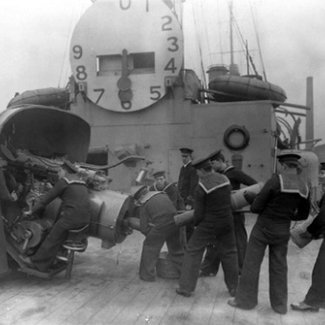On this day: The birth of Royal Australian Navy

BY MID-MORNING ON 4 October 1913 Sydney Harbour was humming as thousands of people lined its edges and small waves crested between boats jostling for water space. Topping off the anticipatitory hype was celebrity balloonist Captain Taylor Penfold, who hovered surreally above it all.
By 10:30am the grey hulls of battlecruiser HMAS Australia, cruisers Melbourne, Sydney and Encounter, and destroyers Warrego, Parramatta and Yarra could be seen moving through Sydney Harbour’s headlands.
As band on the Australia‘s quarterdeck broke into a stirring rendition of Rule Britannia (the anthem of the British Admiralty) the Royal Australian Navy was born.
British Royal Navy vs Royal Australian Navy (RAN)
This fleet had been at least a century in the making, but less than a year later the ships would be manoeuvring in the midst of WWI.
Before WWI most large scale naval conflicts had been distant. Nonetheless, Australia is a nation “girt by sea” and the issue of an Australian fleet had been raised many times. However, the world-famous British Royal Navy was considered enough by most and the issue stalled for almost a century.
Federation in 1901 saw the issue of nation-building come to the forefront. By 1909, then prime minister Alfred Deakin secured the funding to build an Australian fleet, as naval races began to play out ominously between Britain, Germany and the United States.
To bolster support for the project Deakin had cannily issued an invitation to the ‘Great White Fleet’ of the United States Navy: 16 gleaming warships that visited Sydney and Melbourne in 1908. By all accounts Australians were mightily impressed by the sight.
In 1910, Deakin’s successor Andrew Fisher politely rejected a loan from Britain, which had previously been accepted, to help fund the fleet in a symbolic step out of the shadow of Mother Britain.
(*Most of the Australian colonies had already established volunteer citizen reserve naval brigades by 1884, which had become Commonwealth Naval Forces in 1907.)
The power of HMAS Australia
When it came to building the first Australian fleet, Deakin commissioned only the best says historian Mike Carlton.
In his book First Victory, 1914, he writes that the HMAS Australia was the modern equivalent of “if today’s RAN [Royal Australian Navy] were to buy an American nuclear submarine equipped with intercontinental ballistic missiles”.
The Australia required 800 crew to function and acquitted itself admirably during WWI, fending German ships off the Australian coastline and crossing the world to support European naval efforts.
It was sunk in Sydney Harbour in 1924 as part of a post-war agreement to reduce naval forces and remains the largest shipwreck in Australian waters.
Today, the Royal Australian Navy consists of 53 vessels and over 16,000 personnel. As one of the biggest forces in the Pacific region, it has a significant presence in the Indian Ocean and supports military campaigns and peacekeeping missions around the world.
Gallery captions by Jefferson Penberthy
RELATED STORIES

